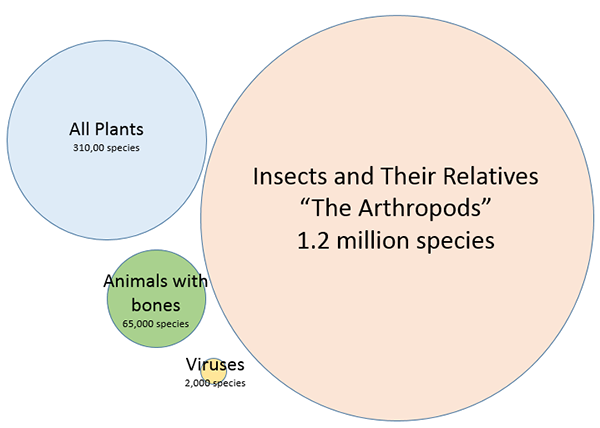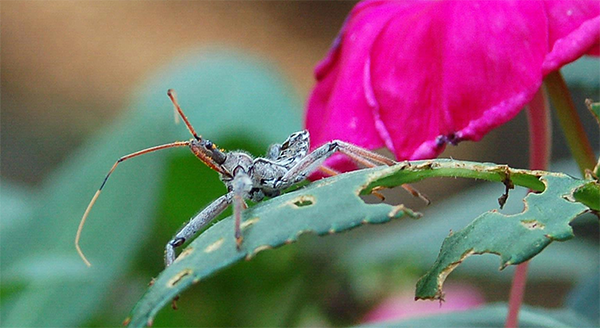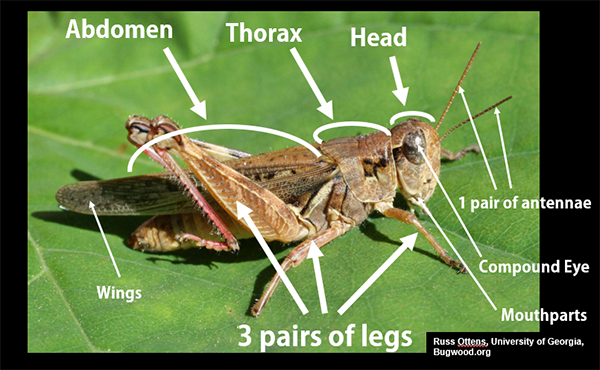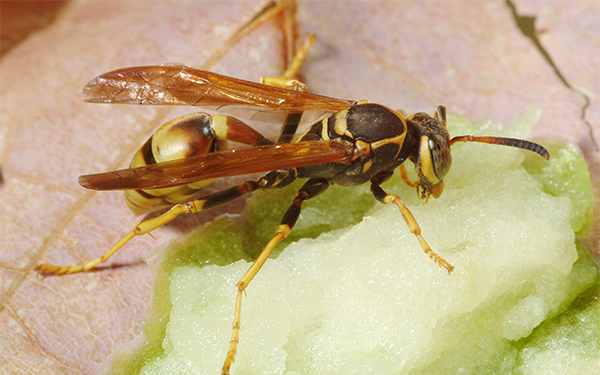Arthropods & Insects
Return to: Entomology for Master Gardeners Main Page
Introduction
Insects are very small, but they make a big impact. Out of the aproximately 1.8 million known species on earth, about 1 million of them are insects. That means that there are more kinds of insects on earth than all other kinds of animals, plants, fungi, and even viruses and bacteria, combined. If you add in the other arthropods--that is, the other creatures that are closely related to insects, like spiders, ticks, and crustaceans--the number growns to about 1.2 million known species. Insects and there relatives are found in almost every habitat on earth. In Kentucky, they are found in essentially every habitat, from treetops to roots, the sky to the bottoms of rivers, and from the wilderness to the home. Of course, gardeners know that insects are very common on tomatoes, roses, and melons. Kentucky has about 15,000 known species of insects. Fortunatly, only a few of those species are harmful to plants. With a little bit of entomological knowledge, gardeners can learn to tell the "bad" bugs from the beneficial ones, proper identification is the most important step in any pest control attempt.

The circles above show that there are more known species of insects and their relatives than, for instance, all known plants, animals with bones (mammals, birds, reptiles, amphibians, and fish), and viruses.
Why Is Identifcation Important?
In the UK Master Gardener Program, instructors often remind participants that proper identification is the most important part of any pest control attempt. Improper identification can lead to wasted time, wasted money, and can casue even worse problems for your plants.
For example, in the image below an insect is sitting on a leaf that has been damaged by insect feeding. Perhaps this creature caused the damage, and needs to be controlled with a pesticide? Closer examintion reveals that this creature did not cause the damage, however. This is an imature assassin bug, which is a beneficial predator in the garden. Its straw-like mouthparts (which are visible here, folded under the eye between the antennae) are designed to pierce-and-suck prey--it is physically incapable of chewing a leaf. Killing it would not only waste time and rid the plant of a valuable ally, but the real "culprit" would remain at large. The real pest is most likely a moth caterpillar or a beetle: they are the most common "chewing" pests in a garden.

Assassin bug nymph on a leaf. It may have already killed the insect that has caused the damage (Photo: Alan Matthews, Bugwood.org).
What is an Arthropod?
To understand what an insect is, it is a good idea to know a little bit about arthropods. Arthropoda is simply a very big group (or "PHYLUM") of animals that includes the insects plus all of their relatives, including spiders, ticks, crabs, and other small invertebrates (that is, creatures without internal bones) with multiple pairs of legs. The definition of an arthropod is any creature that has:
- no internal skeleton
- multiple pairs of jointed, segmented legs
Some examples of creatures that are NOT arthropods include: slugs, snails, earthworms, snakes. and starfish.
What are the Five Classes of Arthropods?
There are five groups, or CLASSES, of arthropods found in Kentucky. Learning the differences between them is the first step in identification. The chart below shows the classes along with some ot their characteristics:

Arachinda Arachnida is a large class that includes many different types of organisms, including all spiders, mites, ticks, daddy longlegs, and scorpions. Arachnida have four pairs of walking legs and two body regions: the head and thorax are one region and the abdomen is the other. These two regions are clear in spiders. Mites, ticks, and daddy longlegs, however, look as if they have only one region, and a scorpion, because of its segmented tail, appears to have more than two. arachnida never have antennae. Other than some a few important pest species of mites, arachnids found in Kentucky gardens do not damage plants. To learn more about common Kentucky arachnids, visit these pages: Spiders | Daddy Longlegs | Scorpions | Mites & Ticks
Diplopoda Millipedes have typically 40 or more pairs of short legs, with two pairs attached to each body segment. They generally feed on decaying organic matter, helping to break it down into smaller pieces. Millipedes can be difficult to distinguish from centipedes, but millipedes generally move very slowly, while centipedes general can move very fast. Occasionally, millipedes feed on plant roots or leaves in contact with the soil. They are common in gardens but are generally beneficial. Learn more about Kentucky Millipedes.
Chilopoda Centipedes have at least 15 pairs of legs, with one pair of legs attached to each body segment. These fast-moving predators use a pair of fangs (modified legs) on the segment behind the head to bite and paralyze their prey. They are common in mulch and leaf litter in gardens and are beneficial predators. Read more about Kentucky Centipedes.
Crustacea Crayfish, lobsters, and crabs are the biggest and best-known members of this class. Most live in the water and breathe by gills or through the exoskeleton. Pillbugs and sowbugs are among the few crustacteans that live on land, but they have gills and must stay in humid areas to survive. Pillbugs and sowbugs are the only crustaceans that are common in Kentucky gardens and they are beneficial decomposers in most cases. Learn more about Kentucky crustaceans: Sowbugs | Crayfish
Insecta. Insects are the main focus of this chapter and there are more kinds of insects than all of the other arthropod classes combined. With some exceptions (most notably, mites) most of the important garden pests are insects, but there are many beneficial insect species too. Insects can be plant-feeders, predators, or decomposers, depending on the species. Insects have 3 pairs of legs, 3 body regions (head, thorax, abdomen), and 1 pair of antennae.
What is an Insect?
An insect is a special kind (or "CLASS") of arthropod. To be a member of the Class Insecta, a creature must first be an arthropod (it must have no internal skeleton and it must have paired, segmented legs). An insect will have, in addition, these characteristics:
- three pairs of jointed, segmented legs
- three main body regions (head, thorax, abdomen)
- one pair of antennae
Insects will also OFTEN have wings (not all insects have wings, but NO other arthropods ever have wings). As mentioned above, insects make up most of the arthropod species on earth, with about 1 million species on earth and 15,000 in Kentucky.
Insects include: dragonflies. grasshoppers, crickets, walkingsticks, mantids, roaches, termites, lice, stink bugs, assasin bugs, cicadas, aphids, beetles, butterflies and moths, flies, bees, ants, and wasps, plus many other creatures.
What Are the Insect's Body Parts?
Like humans, insects have hundreds of body parts, but, in most cases, there are only a few that are important for identification purposes. The most important are the three main body regions. Each of these have additoinal importaant parts associated with them.
- Head: an insect's head is the location if its mouthparts and its most noticable sensory structures, the single pair of antennae and the eyes. Most adult insects have compound eyes, which are actually made up of dozens or hundreds of individual facets. Most insects also have simple eyes, which are very small and difficult to see without a microscope.
- Thorax: the insect's thorax is the home of its most important locomotory structures, the three pairs of legs and the wings. Often, wings will also cover the insects abdomen when they are at rest, but insect wings always "sprout" from the thorax. Not all adult insects have wings, but most do. No immature insects have wings. Most adult insects have four total wings (two on each side) but all true flies (order Diptera, which includes house flies, crane flies, and mosquitoes) always have two wings.
- Abdomen: the abdomen is the rear part of an insect. It begins just after the last pair of legs. Abdomens often lack distingushing structures, but may be the home to stingers and egg-laying structures.

Labeled image of a grasshopper, showing the main body parts.

This wasp is very different from the grasshopper above, but since it is an insect it still has the same basic body parts. See if you can find the head, thorax, abdomen, wings, legs, eyes, mouthparts, and antennae (Photo: Joseph Berger, Bugwood.org).
A Note About Immature Insects Like human children, immature insects often break the rules, even the rules of anatomy. On this page we have said that insects "always" have three body regions and three pairs of legs. This is always true for adult insects, but not always for immature stages, especially those insects that go through complete metamorphosis. Many larval insects, like maggots for instance, have no legs at all. But the adult fly will have all three pairs of legs. Likewise, the three body regions are sometimes difficult to distinguish in larval insects.
